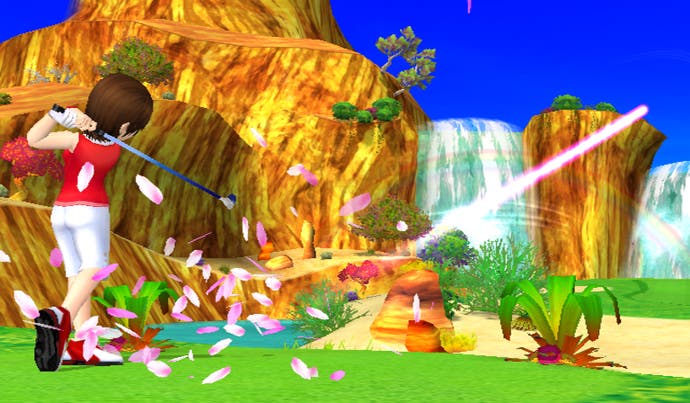We Love Golf
Bit presumptuous.
It's been nearly two years and we're still waiting for a Wii sports game that does something better than Wii Sports, but surely if anyone can get it right it's Camelot? Nintendo's partner on the Mario Golf games and the developer of the original Everybody's Golf on PlayStation, the Japanese company has been making golf games for as long as Tiger Woods has been playing professionally. We Love Golf - published by Capcom and out in the UK this Friday - adopts a similar approach in modes and presentation but switches controls to the Wii remote and refuses to offer a friendly two- or three-tap alternative as a safety net.
The control system encourages you to swing the remote like a golf club, holding the A button for the duration of your swing. Behind the scenes, it measures the angle of the Wiimote as you rotate it through a backswing motion, which moves a brightly-coloured club-head cursor along a familiar-looking power gauge. You then bring the Wiimote down as though you're striking a golf ball.
More important than your swing though is your timing. A ghostly club-head icon also moves along the power gauge, and the idea is to pause the Wiimote at the top of your swing until it overlaps with the brightly-coloured club-head that tracked your motion, and then start your downswing. You mustn't thrash it down wildly though, because you also have to time your swing so that the Wiimote hangs vertically in your hands around waist-height - the point at which it would strike the ball if it were actually a golf club - at the same time as the ghostly club-head icon reaches the centre of the power gauge's impact zone.
Once you've mastered this, you can start adding draw and fade (sidespin, effectively) by twisting the face of the Wiimote slightly in your grip, and add topspin or backspin while in flight by hitting the 1 or 2 buttons. There's also the option of performing power shots by lifting the Wiimote to an even steeper angle before swinging. That's not all the controls though, because you also need to line up your shots, move the camera around to explore the course and switch clubs. This functionality is spread around the d-pad, B button and plus and minus buttons.

You don't need me to tell you that the above is rather complicated and abstract. But you might want me to tell you that you can actually master the game sitting down if you're lazy enough: just hold the Wiimote by the bottom and lift the tip up and round as though you're swinging a pendulum. Not only does it work, but it allows for more precise manipulation of the club-head icon and better timing on the power gauge. You also run less risk of twisting the controller and accidentally spinning the ball into the rough. The bottom line is that whichever way you play it, it works very effectively after an hour or so of experimentation.
And that's the problem really: the control system works, but the game clearly isn't taking any chances, so you're given every possible assistance on the course. You're shown distances to the tee and pin from any position, wind speed, ground conditions, elevation, whether the ball will strike trees or rocks, impact projection and the direction the ball will roll on landing. You can also adjust shot length so that you can see exactly how much power is required on the gauge.








